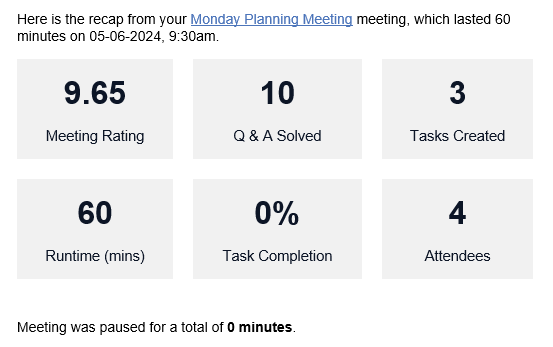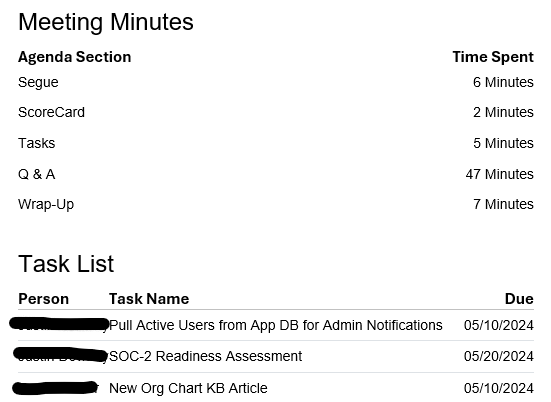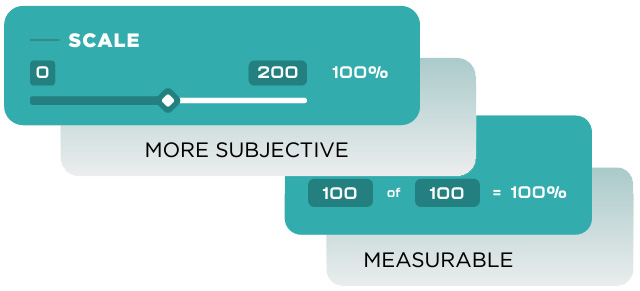Think about the last meeting you attended; who was there, what did you accomplish, how long did you discuss particular topics, and how did it impact your day? Most importantly, what was the return on investment from that meeting? Here is the thing, we have a lot of meetings. Meetings take time, and time is money in the workplace. There is ultimately a cost to every meeting, and it is our job to ensure we’re using everyone’s time responsibly.
- Keeps Meetings Organized
- Automatically Keep Meeting Minutes- Down to the Topics Covered
- Fosters Accountability
- Creates Visibility Around Action Items
You can imagine the expense over a course of a year of unproductive hours used in disorganized meetings! Performance Scoring is designed to stop this waste and make meetings matter. The thoughtfully designed platform optimizes your meeting time so you get the most ROI from every meeting.
A survey of 182 senior managers found that 71% feel that meetings are unproductive.
Here is how:
Allotted time for engagement and encouragement at the start. Often-times we neglect the human element of our work, and as a result, we miss an opportunity to build trust amongst team members and build momentum on successes of the previous week. Part of the value of meetings is that they facilitate connection among employees. Having a segue built into every meeting agenda ensures that you are habitually focusing on the positive and building trust amongst your team.
The bulk of the meeting shouldn’t be chit-chat, of course. However, beginning the meeting with a short time dedicated to relationship building facilitates the connection needed for heightened engagement, positivity, and collaboration throughout the rest of the meeting.
Performance Scoring’s built-in meeting structure begins with a segue question (brief “fun” question) and shout-outs (an opportunity for meeting attendees to shine light on each others’ accomplishments). With Performance Scoring, this time is segmented and measured, ensuring that the entire meeting is not hijacked by socializing. Instead, we learn something new about meeting attendees, build trust through recognizing one another, and are reminded to move forward with the meeting agenda after this allotted time.
Keep the Meeting Organized
Side bar conversations might seem like no big deal, but; if they happen consistently, they can become incredibly costly. Facilitating a stronger structure with technology can drastically improve your meeting efficiency.
After creating the human connection and building trust amongst your team, we recommend you go right into the reporting section of your meeting. You can keep the meeting focused by reviewing things like a scorecard or quarterly goals. With an organized scorecard, all meeting participants can see where they are and where they’re headed.
Performance Scoring ensures that your meeting has a structure that pushes progress. It generates a thoughtful meeting agenda, breaking your precious meeting time into timed segments: a segue question, shout-outs, to do’s, solving ongoing issues, and a wrap up.
Healthy Time Pressure Pushes Engagement
You have likely heard of Parkinson’s Law. It is the idea that, “work expands to fill the time available for its completion.” The best meetings have a healthy amount of time pressure that keeps attendees alert and engaged. In other words, they are not too long and not too short.
Work expands to fill the time available for its completion.
Parkinson’s Law
Having a visual ticking clock provides a healthy awareness and pressure so that we consciously make use of meeting time. The presence of a timer helps keep everyone on your team engaged and also encourages everyone to come prepared as they will know that every second counts.
Staying on time is easier said than done. Especially if you are the one running the meeting, while trying to keep time and taking notes. Luckily, there are tools that can make that a seamless and stress free process. Performance Scoring has an adjustable running clock that times each section of the meeting and enables you to see where you are in the meeting and what still needs to be covered. Tracking time allows you to discern and tweak meeting times so that they are optimal for productivity.
Document Action Items for Accountability
Meetings are ultimately there for the purpose of getting things done. If an action item isn’t documented and paired with a deadline and accountability, there is a good chance it is not going to be a priority. Years of research reveals that employees tend to do a lot of work with projects right at the beginning, then put it off, and then scramble to finish everything right before a project deadline (don’t lie we’ve all done it).
By creating visibility around the action items and having to report progress updates in meetings, you will see more spikes in productivity. For example, if a project were a year long, we would likely see 52 spikes of productivity with a weekly rhythm of to-do’s and an accountability report.
Meeting attendees need clear action items, documented in a software that they can access on a daily basis with built-in accountability; a software like Etho. Within every meeting, you can create to-do’s or project milestones that need to be accomplished to chip away at the larger initiative.
Create a shared sense of purpose.
Meeting success comes from active participation from every attendee. Sharing the agenda and goals with the team helps provide a shared sense of purpose because everyone understands the importance of the meeting and why they have been included.
Team members may also become more involved if they feel that their work and opinions are genuinely valued. A shared purpose is motivating both during the meeting as you discuss different topics and after; when the team agrees on a solution and disperses to work on their individual action items.
A meeting is meant to be a, “meeting of the minds.” Every team member needs space in each meeting to talk through their biggest challenges and opportunities so that you can then work as a team to bring solutions.
Performance Scoring’s meeting platform includes an interactive QA section where every employee can bring a QA to the table and then work through the solution with teammates or managers directly in the Performance Scoring platform.
Performance Scoring gives your team the power to solve issues in ways that are actionable and accomplishable, while holding team members accountable with specific assignments. With Performance Scoring, you can assign smaller Tasks to bigger goals that fall within the overall organizational mission. This integration to broader goals also reminds employees of the significance of their work.
Send a Simple Summary of the Meeting
After the meeting, it is critical that you email a summary to all relevant parties, even people who couldn’t attend. What good would all that time and work have been if action items or key takeaways were missed.

A simple recap should include the topics of discussion, the goals for the next meeting, an attachment of the slideshows or handouts, if applicable, and meeting ratings. Taking a rating of the meeting at the end gives you a reflection about them which will help your organization to improve. It also goes a long way to showing employees that meeting quality matters.

It is important that everyone has the same information, including what their assigned tasks or goals are. Performance Scoring makes it easy to send a summary at the end of every meeting. With just one click of a button, everybody will receive a recap email with the meeting minutes, meeting ratings, takeaways, tasks, and to-do’s directly in their inbox.




![5 Ways to Improve Employee Engagement Through Feedback [brandname]-feedback-featured](https://securedb.io/kb/wp-content/uploads/2023/04/etho-feedback-featured.jpg)
